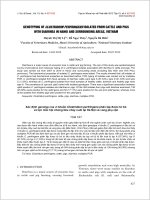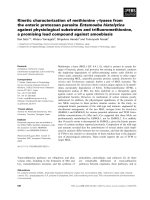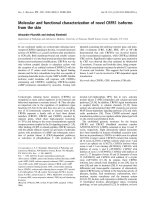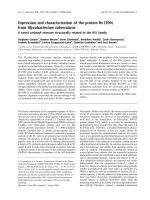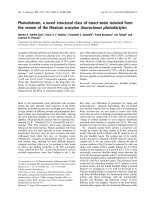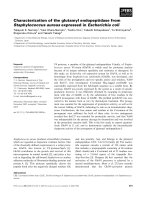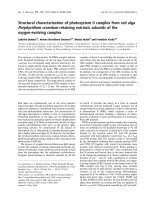Characterization of coagulase-negative staphylococci isolated from hospitalized patients in Narayana medical college and Hospital Nellore, A.P. South India
Bạn đang xem bản rút gọn của tài liệu. Xem và tải ngay bản đầy đủ của tài liệu tại đây (216.23 KB, 8 trang )
Int.J.Curr.Microbiol.App.Sci (2017) 6(5): 1034-1041
International Journal of Current Microbiology and Applied Sciences
ISSN: 2319-7706 Volume 6 Number 5 (2017) pp. 1034-1041
Journal homepage:
Original Research Article
/>
Characterization of Coagulase-Negative Staphylococci Isolated from
Hospitalized Patients in Narayana Medical College and Hospital
Nellore, A.P. South India
Nadakuduru Premanadham*, Muni Lakshmi and B. Siva Prasad Reddy
Microbiology Department, NMC Nellore, India
*Corresponding author
ABSTRACT
Keywords
Coagulasc-ncgativc
Staphylococci;
Antimicrobial
susceptibility;
Nosocomiai
infection.
Article Info
Accepted:
12 April 2017
Available Online:
10 May 2017
Coagulase-negative staphylococci (CNS) are a main cause of nosocomial infection. The
main purpose of this study was to determination of frequency of CNS isolates in in
hospitalized patients and their susceptibility pattern to antimicrobial agents. During 11
months study, 147CNS clinical isolates were recovered from hospitalized patients in NMC
& hospital Nellore south India. The age of patients was 10 t0 70yrs. In vitro susceptibility
of isolates to 14 antimicrobial agents – ampicilin, oxacillin, cefexime. azithromycin,
oflaxacin, clindamycin, amikacim, tegycyclin, vancomycin, tegycyclin. vancomycin,
amoxicillin with clavalinic acid, Tycarcillin with clavalanic acid, piperacillin with
tazobactum. sporflaxacin and linezolid was performed by Kirby-Bauer’s Disk diffusion
method according to Clinical and Laboratory Standards Institute (CLSl) criteria. Out of
147 patients were infected with CNS during study periodin different clinical specimens
includes fifty four (36.73%) were isolated from urine. Fifty three (36.05%.) from the pus
21(14.29%) from sputum, 19(12.93%) from blood samples. Most of CNS isolates were
sensitive to linezolid 134(91.16%), tegycyclin 130(88.44%) and vancomycin 123(83.67%).
Highest resistance seen cefexime 96(65.31), azythromycin 79(53.74%), ampicillin
76(51.70%) Multi-drug resistant CNS with reduced susceptibility to linezolid, vancomycin
emerging pathogens of clinical concern. Monitoring of antibiotic resistance with attention
to multi-resistant profile and aware to practitioners in the field is necessary.
Introduction
Nosocomial infections are important public
health problems in developing countries as
well as in developed countries. Nosocomial or
hospital acquired infections are usually
defined as infections that are identified at
least 48-72 hours following admission to.
hospital and health care facility (Ziebuhr et
al., 2006). The most frequent types of
nosocomial infections are bloodstream
infection (BSI) urinary t1 act infection (UTI)
pneumonia and surgical wound infection
Celik et al., 2005). Coagulase-negative
staphylococci (CNS) are a group of microorganisms that known as normal biota of
human skin and mucous membranes. CNS are
consisting of 39 Species and 16 Species of
them are known to cause infection in human.
Since 1970, CNS is recognized as important
agents of a wide variety of human nosocomial
infections. They account for 9% of
nosocomial infections (Piette et al., 2009).
1034
Int.J.Curr.Microbiol.App.Sci (2017) 6(5): 1034-1041
The two most frequently encountered CNS
species in clinical samples are Staphylococcus
epidermidis
and
Staphylococcus
saprophyticus. Overall, S. epidermidis is the
predominant agent in nosocomial infection,
bacteremia, intravascular catheter-related
infections, endocarditis, central nervous
system shunt infections, urinary tract
infections, ophthalmologic infections, dialysis
related infections and surgical wounds while
saprophyticus is more associated with urinary
tract infections in females. Therefore, CNS
isolates have received more attention recently
as a cause of above mentioned infections
(Guirguitzova et al., 2002). Accurate species
level identification of CNS is expensive and
time consuming .according to past
researchers, identification to species level is
not necessary for good patient management
and treatment (Heikens et al., 2005).
Nowadays the role of CNS as potential agents
of nosocomial blood stream infections and
UTI has been recognised CNS isolates
account for30% nosocomial blood stream
infections.
Among
CNS
isolates
Staphylococcus
epideimidis
is
most
frequently associated with blood stream
infection (Javadpour et al., 2010). The use of
indwelling medical devices such. as central
and peripheral venous catheters, artificial
heart valves, valvular prostheses, pace-makers
and orthopaedic prostheses in patients is the
one of main predisposing agents S.
epidermidis bacteremia (Stoll et al., 2002).
UTI is one of the most frequent types of
nosocomial infections and probably affects
about one-half of all people during their
lifetimes.
Many
of
clinicians
are
commonly
encountered with UTIs in developing
countries. UTI refer to the existence of
microbial pathogens in the urinary tract and
defined as the growth of a single pathogen of
>105 colony-forming units per millilitre from
properly
collected
mid-stream
urine
specimens (Barisic et al., 2003). UTIs are
often caused by different bacteria. Bacterial
agents are responsible for a spectrum of UTI
that can be ranged from mild irritative voiding
to bacteremic sepsis and death; UTIs can
often be symptomatic or asymptomatic
(Stamm et al., 2001).
The major causatives of UTIS are Escherichia
coli and other Enterobactericae. Although
relative frequency of the pathogens varies
depending upon age, sex, catheterization and
hospitalization but in complicated urinary
tract infections and hospitalized patients,
Gram negative rods complicated urinary tract
infections and hospitalized patients, Gramnegative rods (Pseudomonas spp) and gram
positive
cocci
(coagulase
negative
Staphylococci,
Staphylococcus
aureus,
Streptococcus group B, Enterococci) are
comparatively more common (Ronald, 2003).
Recently, in all over the world, resistance to
antibiotics among CNS isolates has been
reported. The infections associated with CNS
requiring surveillance of antimicrobial
therapy. In appropriate use of antimicrobial
agents in treatment of patients recently has led
to the spread of antimicrobial resistance
among CNS isolates. On the other hand,
widespread resistance among CNS isolates is
major problem for the empirical treatment of
nosocomial infections (Stamm et al., 2001;
Ronald, 2009). During the past decade CNS
isolates exhibited a remarkable ability “to
rapidly develop antibiotic resistance. Areaspecific monitoring studies in order to
detection of antimicrobial resistance patterns,
effective treatment and decrease mortality
rates is necessary.
Considering lack of information about
antimicrobial resistance profiles of CNS
clinical isolates and increasing infections, the
object of this study was to investigate the
1035
Int.J.Curr.Microbiol.App.Sci (2017) 6(5): 1034-1041
frequency of CNS isolates in hospitalized
patients and their susceptibility pattern to
commonly used antimicrobial agents.
Materials and Methods
Bacterial Isolates
The present descriptive study was performed
on cases who were hospitalized in different
wards of hospital. A total of 147 clinically
significant CNS isolates from different
clinical samples for a period of 11 months
(from Jun 2014 to May 2015) CNSs were
isolated from sputum, blood, pus, and urine
samples. Isolates were diagnosed as true
pathogen when isolated in pure culture from
infected sites. UTI refer to the existence of
microbial pathogens in the urinary tract and
defined as the growth of a single pathogen of
>10 colony-forming units per milliliter
(CPU/ml) from. properly collected midstream
urine specimens. All the cases had history of
nosocomial infection and clinical examination
was conducted by physician to exclude
community-acquired infections.
The plates were incubated in aerobic
conditions at 3 7 °C for 24-48 hours. Negative
cultures were maintained 1n incubator up to 2
days. Identification of specimens was
performed by Grams staining, catalase,
manitol fermentation and coagulase tests and
other conventional
biochemical tests.
Coagulase test was done both slide and tube
methods (Clinical and Laboratory Standards
Institute, 2012). Samples confirmed as a CNS
isolates were stored in Tryptic Soy Broth
containing 20% glycerol at 70°C and were
subjected to further investigation
Standards Institute (CLSI; formerly National
Committee for Clinical Laboratory Standards)
criteria (Ghadiri et al., 2012). The following
antimicrobial agents were used in this study:
Ampicilin; oxacillin Cefexime; azithromycin,
oflaxacin, amicacin tegycyclin, vancomycin,
clindamycine, amoxicillin with clavulanic
acid, ticarcillin with clavalinic acid,
pippercillin with tazobactum, sporflaxacin,
linazolid.
Briefly, the bacterial suspension obtained
from overnight cultures. The turbidity of each
bacterial suspension was adjusted equivalent
to a no. 0.5 McFarland standard and then
inoculated on Mueller-Hinton agar Diameter
of inhibition zones was measured after
incubation at 3 5°C for 18-24 hours, and data
were reported as susceptible and resistance
Results and Discussion
Over a period of 11months study CNS
accounts for 147 isolates in hospitalized
patients. The age range of the patients was
from 2 to 70 years. 147 isolates of which
there were 67 (45.58%) females and 80
(54.42%) males as shown in table 1.
Occurrence of infection with CNS was
highest in the age group 40 to 49 year
29(19.73%) and the lowest in the age less
than 10 years 3(2.04%)
In males, majority of the CNS found in the
age group 50 to 59 years 19(12.93%) and in
females age group 20 to 29 years 17(11.56%).
Frequency of CNS in different age groups is
shown in table 2
No much significant difference was found
between isolated bacteria and age of the
patients
Antimicrobial susceptibility testing
To evaluate antimicrobial susceptibility of
isolates Kirby-Baue1’s Disk diffusion method
was done according Clinical Laboratory and
Among 147 isolates of CNS, 54(36.73 %)
were isolated from the urine 53(36.055%)
1036
Int.J.Curr.Microbiol.App.Sci (2017) 6(5): 1034-1041
from pus, 21(14.29%) from sputum and
19(12.93%) from blood sample. High % of
isolates are from urine followed by pus,
sputum and blood as shown in table 3.
All isolates of CNS were negative for free and
tube coagulase.
The profile of isolated bacterial showed wide
different level of resistance for tested
antibiotics (Data are shown in table 4).
Antibiotic susceptibility testing of the isolates
showed maximum resistance cefexime
93(65.31%)
azytromycin
79(53.74%)
ampicillin 76 (51.70%) followed by
clindamycin 47 (31,97%). Oxacillin 43
(29.25%), tecarcillin with clavulanic acid 43
(29.25%), amoxicillin with clavulanic acid 40
(27.21%), sporflaxacin 34(23.13%), amikacin
31(21.09%). oflaxacin 30(20.14%).
Most of the isolates were sensitive to
linazolid, tygycyclin, vancomycin.
Multidrug resistant (MDR) was defined as
resistance to at least three or more antibiotics.
Nosocomial infection is a global problem that
affects both developed and developing
countries. Recent studies have revealed the
importance of CNS as one of the causes of
nosocomial or healthcare related infections.
Many of nosocomial infections are associated
with microorganisms that are resistant to
antibiotics and can easily spread by hospital
environment and personnel. Monitoring of
antimicrobial susceptibility can aid to
clinicians for prescript appropriate antibiotics
and prevent the development of drug
resistance (Cleven et al., 2006). Effective
treatment of patients with UTI and blood
stream infections associated with CNS
commonly relays on the identification of the
type of organisms and the selection of an
effective antibiotic agent to the organism in
question. The pattern of antimicrobial
resistance of CNS producing infection varies
in different regions and especially different
wards. In this study, the frequency of CNS
isolated from hospitalized patients are
67(45.58%) females and 80 (54.42%) males.
Among different clinical samples, CNS
isolates were isolated from 54 (36.73 %) urine
samples foll0wed by pus 53(36.05%) sputum
21(14;29%) and blood 19(12.93%). CNS
isolated from urine 54(36.73%) is highest.
This result is consistent with the results of
recent studies in India (Asangi, 2011;
Sarathbabu et al., 2011). In a study done by
Vaez et al., in 2012, CNS was mostly isolated
from blood cultures that are in contrary with
our study (nellore). In another study done by
Banelj et al., 72 of 150 strains of CNS (60%)
were isolated from blood samples, 36(24%)
from pus samples, 15(10%) from urinary
catheter tip and 12(8%) from the urine
samples. The sex distribution of patients in
our study female was between 20 to 49 years.
This result is similar to those reported from
many other researchers.
In this study, we investigated the frequency
and antimicrobial susceptibility patterns of
CNS isolated This study revealed that all of
CNS isolates were mostly sensitive to
linazolid, tegycyclin and vancomycin. Our
finding about vancomycin is in accordance
with: studies done in India 2012, Spain 2002,
England 2004, Asia Pacific region 2007, USA
2007 and Turkey 2007 (Cuevas et al., 1986;
Reynolds et al., 2002).
In our study, the highest resistance rate of the
CNS was against cefexime 9365.31(%)
followed by azytromycin 79(53.74%)
ampicillin
76(51.70%)
followed
by
clindamycin
47(31,97%).
Oxacillin
43(29.25%), tecarcillin with clavulanic acid
43(29.25%), amoxicillin with clavulanic acid
40(27.21%),
sporflaxacin
34(23.13%),
amicacin 31(21.09%), oflaxacin 30(20.14%).
1037
Int.J.Curr.Microbiol.App.Sci (2017) 6(5): 1034-1041
This study correlates with a study by Asangi
et al., where the antibiotic susceptibility
testing showed maximum resistance to
ampicillin. In study Sader et a1., (2007) 85°095% of CNS were resistance to ampicillin and
penicillin. High resistances to these
antibiotics have been reported by several
researchers. Resistance to
ampicillin,
cefexime azithromycin, among our isolates
may related to improper usage of this
antibiotic for treatment of other infections,
increase use of other beta lactam antibiotics in
hospital and acquisition of resistant during
hospitalization.
Erythromycin
(azythromycin)
increased
progressively in CNS from 41% in 1986 to
63% in 2002 (20). Asangi et al., showed high
level of resistance to erythromycin among
CNS isolates. In two surveillance studies,
performed in 2006, in US and Europe CNS
isolates had increased resistance rate to
erythromycin (Jones et al., 2006). The
possible reasons of high resistant rate to
erythromycin may be related to use of
erythromycin in treatment of disease caused
by CNS and common infections, increase
exposure of this isolates to new macrolide,
efflux of the drug and ribosomal methylation.
Cross resistance between clindamycin and
macrolides is well described by several
investigators.
Resistances to Eryrhromycin (azytrornycin)
have been reported differently by several
researchers. In Spain, resistance to
Table.1 Sex wise distribution
Total male
Total female
Total
80(54.42%)
67(45.58%)
147(100.00%)
Table.2 Age wise distribution
AGE
<10
10 TO 19
20 TO 29
30 TO 39
40 TO 49
50 TO 59
60 TO 69
>70
MALE
2
5
8
11
14
19
13
8
%
FEMAIL
%
TOTAL
1.36%
1
0.68%
3
3.40%
4
2.72%
9
5.44%
17
11.56%
25
7.48%
6
4.08%
17
9.52%
15
10.20%
29
12.93%
8
5.44%
27
8.84%
10
6.80%
23
5.44%
6
4.08%
14
Table.3 Sample wise distribution
Blood
Pus
Sputam
Urine
Total
19
53
21
54
147
1038
12.93%
36.05%
14.29%
36.73%
100.00%
%
2.04%
6.12%
17.01%
11.56%
19.73%
18.37%
15.65%
9.52%
Int.J.Curr.Microbiol.App.Sci (2017) 6(5): 1034-1041
Table.4 Results of antibiotic susceptible test
S.No.
Antibiotics
No of
No of susceptibility Total
resistance
76(51.70%)
71(48.30%) 100.00%
43(29.25%)
104(70.75%) 100.00%
96(65.31%)
51(34.69%) 100.00%
79(53.74%)
68(46.26%) 100.00%
30(29.47%)
117(79.59%) 100.00%
47(31.97%)
100(68.03%)
31(21.09%)
116(78.91%) 100.00%
17(11.56%)
130(88.44%) 100.00%
24(16.33%)
123(83.67%) 100.00%
40(27.21%)
107(72.79.03%) 100.00%
1
2
3
4
5
6
7
8
9
10
Ampicillin
Oxacillin
Cefixime
Azithromycin
Ofloxacin
Clindamycin
Amikacin
Tegycycline
Vancomycin
Amoxycillin+Clavulanic Acid
11
Ticrcillin with Clavlanicacid
43(29.25%)
104(70.75%)
100.00%
12
Piperacillin+Tazobactam
28(19.05%)
119(80.95%)
100.00%
13
14
Sparfloxacin
Linezolid
34(23.13%)
13(8.84%))
113(76.87%)
134(91.16%)
100.00%
100.00%
The resistance rate to linzolide was 8.84% in
our study. US and Turkey, Englans, Australia
and Irland linazolid resistance is higher
(Biedenbach et al., 2007). The resistance rate
to gentamicin in among CNS isolates was
higher than other studies (Zia et al., 2010;
Khorshidi et al., 2003). The data from our
investigation exhibited that ampicillin,
penicillin, cefoxime, cefalotin, gentamycin,
oxacillin and erythromycin had not good
activity against CNS isolates.
It should not be ignored that MDR strains of
CNS can serve as a reservoir of resistance
genes and can spread to the other
microorganisms. Therefore, in order to
prevent further spread of multi-drug resistant
CNS, the use of antibiotics should be
monitored and implementation of infection
control. In the other hand, continued use of
antibiotic for treatment of infections
associated with CNS isolates should be
supported by monitoring of antimicrobial
susceptibility to prevent the spread of
resistant isolates and also eliminate the use of
antibiotics for a prolonged period. Resistant to
linzolid tegycycline and vancomycin has seen
minimum among our isolates it seems that
them can be effective drugs for treatment of
infections associated with CNS isolates.
According to our findings, ampicillin,
penicillin,
cefoxitin,
gentamicin,
and
erythromycin are not effective drugs for
treatment of infections associated with CNS.
Progressive increase in resistant to these
antibiotics and multiple resistances in present
study, may be related to increased usage of
these antibiotics for treatment and also ability
of strains in acquisition of resistance genes to
other organisms of different species. Our
investigation also exhibited that use of
linzolid in order to decrease spread of
resistance gene among CNS isolates must be
revised.
In conclusion, high level of resistance among
CNS isolates limits the use of antimicrobial
Agents for therapy and also the spread of
1039
Int.J.Curr.Microbiol.App.Sci (2017) 6(5): 1034-1041
MDR isolates is threat for hospitalized
patients.
Continuous
surveillance
for
multidrug resistant strains is necessary to
prevent the further spread of resistant isolates.
References
Asangi, S.Y. 2011. Speciation of clinically
significant
coagulase
negative
staphylococci and their antibiotic resistant
patterns in a tertiary care hospital. Int. J.
Biol. Med. Res., 2(3): 735-739.
Barisic, Z., Babic-Erceg, A., Borzic, E.,
Zoranic, V., Kaliterna, V., Carev, M.
2003. Urinary tract infections in South
Croatia: Etiology and antimicrobial
resistance. Int. J. Antimicrob. Agents, 22
Suppl 2: 61-4.
Biedenbach, D.J., Bell, J.M., Sader, H.S.,
Fritsche, T.R., Jones, R.N., Turnidge, J.D.
2007. Antimicrobial susceptibility of
Gram-positive bacterial isolates from the
Asia–Pacific region and an in vitro
evaluation of the bactericidal activity of
daptomycin,
vancomycin,
and
teicoplanin: a SENTRY Program Report
(2003–2004). Int. J. Antimicrobial
Agents, 30(2): 143-9.
Celik, I., Inci, N., Denk, A., Sevim, E,, Yasar,
D., Yasar, M. 2005. Prevalence of
Hospital
acquired
infections
in
Anesthesiology intensive care unit,” Fırat
Tıp Dergisi., 10(3): 132-5.
Cleven, B.E., Palka-Santini, M., Gielen, J.,
Meembor, S., Krönke, M., Krut, O. 2006.
Identification and characterization of
bacterial pathogens causing bloodstream
infections by DNA microarray. J. Clin.
Microbiol., 44(7): 2389-97.
Clinical and Laboratory Standards Institute.
2012. Supplemental tables. Performance
standards for antimicrobial susceptibility
testing;
fifteenth
informational
supplement. CLSI Publication M100 S15,
M2-A11 and M07-A9.Pennsylvania:
CLSI.
Cuevas, O., Cercenado, E., Vindel, A., Guinea,
J., Sanchez-Conde, M., Sanchez-
Somolinos, M., et al. 2004. Evolution of
the
antimicrobial
resistance
of
Staphylococcus spp. in Spain: five
nationwide prevalence studies, 1986 to
2002. Antimicrob. Agents Chemother., 48:
4240–5.
Euzeby, J.P. 2014. LSPN List of prokaryotic
names with standing in nomenclature.
J. Paramed.
Sci. (JPS) Spring, Vol.5, No.2 ISSN
2008-4978 49
Forbes, B.A., Sahm, D.F., Weissfeld, A.S.
2007. Bailey and Scott's Diagnostic
microbiology, 12th edition, Mosby
Elsevier, 842-55.
Ghadiri, H., Vaez, H., Khosravi, S., Soleymani,
E. 2012. The antibiotic resistance profiles
of bacterial strains isolated from patients
with hospital-acquired bloodstream and
urinary tract infections. Critical Care Res.
Practice.
Guirguitzova, B., Chankova, D., Zozikov, B.
2002. Staphylococci as uropathogens
frequency of isolation in hospitalized
patients and sensitivity to antimicrobial
agents. Ann. Urol., 36: 341-7.
Heikens, E., Fleer, A., Paauw, A., Florijn, A.C.,
Fluit, A. 2005. Comparison of genotypic
and phenotypic methods for species-level
identification of clinical isolates of
coagulase-negative staphylococci. J. Clin.
Microbiol., 43: 2286–90.
Javadpour, S., Karimi, E., Karmostaji, A. 2010.
Frequency and anti-biogram pattern of
coagulase negative Staphylococcus in
clinical specimens of Shahid Mohammadi
Hospital in patients, Bandar-Abbas, Iran.
African J. Microbiol. Res., 4(14): 1581-3.
Jones, R.N., Fritsche, T.R., Sader, H.S., Ross,
J.E. 2006. LEADER surveillance program
results for 2006: an activity and spectrum
analysis of linezolid using clinical isolates
from the United States (50 medical
centers). Diag. Microbiol. Infect. Dis.,
59(3): 309-17.
Jones, R.N., Fritsche, T.R., Sader, H.S., Ross,
J.E. 2006. Zyvox® Annual Appraisal of
Potency and Spectrum Program results
for 2006: an activity and spectrum
1040
Int.J.Curr.Microbiol.App.Sci (2017) 6(5): 1034-1041
analysis of linezolid using clinical isolates
from 16 countries. Diag. Microbiol
Infectious dis., 59(2):199-209.
Khorshidi, A., Moniri, R., Shajari, G. 2003.
Antimicrobial Resistance in Gramnegative Bacilli Isolated from Urinary
Tracts Infections. Arch. Razi Ins., 55.
Koksal, F., Yasar, H., Samasti, M. 2009.
Antibiotic
resistance
patterns
of
coagulase-negative staphylococcus strains
isolated from blood cultures of septicemic
patients in Turkey. Microbiol. Res.,
164(4): 404-10.
Piette, A., Verschraegen, G. 2009. Role of
coagulase-negative
staphylococci
in
human disease. Vet. Microbiol., 134: 45–
54.
Prais, D., Straussberg, R., Avitzur, Y.,
Nussinovitch, M., Harel, L., Amir, J.
2003. Bacterial susceptibility to oral
antibiotics in community acquired urinary
tract infection. Arch. Dis. Child, 88(3):
215-8.
Reynolds, R., Potz, N., Colman, M., Williams,
A., Livermore, D., MacGowan, A. 2004.
Antimicrobial susceptibility of the
pathogens of bacteraemia in the UK and
Ireland
2001–2002:
the
BSAC
Bacteraemia Resistance Surveillance
Programme. J. Antimicrobial Chemother.,
53(6): 1018-32.
Ronald, A. 2003. The etiology of urinary tract
infection: Traditional and emerging
pathogens. Dis Mon., 49(2): 71-82.
Sader, H.S., Watters, A.A., Fritsche, T.R.,
Jones,
R.N.
2007.
Daptomycin
antimicrobial activity tested, J. Paramed.
Sci. (JPS) Spring, Vol.5, No.2 ISSN 2008-
4978 50 against methicillin-resistant
staphylococci and vancomycin-resistant
enterococci isolated in European medical
centers BMC Infectious Dis., 7(1): 29.
Sarathbabu, R., Rajkumari, N., Ramani, T.V.
2011. Characterization of Coagulase
negative Staphylococci isolated from
urine, pus, sputum and blood samples.
IJPSI, 2(1): 37-46.
Singh, S., Banerjee, G., Agarwal, S., Kumar,
M., Singh, R. 2008. Simple method for
speciation of clinically significant
coagulase negative Staphylococci and its
antibiotic sensitivity/resistant pattern in
NICU of tertiary care centre. Biomed.
Res., 19(2): 97-101.
Stamm, W.E., Norrby, S.R. 2001. Urinary tract
infections: disease panorama and
challenges. J. Infect. Dis., 183: Suppl 1:
S1-4.
Stoll, B.J., Hansen, N., Fanaroff, A.A., Wright,
L.L., Carlo, W.A., Ehrenkranz, R.A., et
al. 2002. Late-onset sepsis in very low
birth weight neonates: the experience of
the NICHD Neonatal Research Network.
Pediatrics, 110(2): 285-91.
Zia Sheikholeslami, N., Hassanshahi, G. 2010.
The frequency of coagulase negative
Staphylococci urinary tract infections
with antimicrobial resistance pattern in
Rafsanjan. Pak. J. Med. Sci., 26(1): 10710.
Ziebuhr, W., Hennig, S., Eckart, M., Kränzler,
H., Batzilla, C., Kozitskaya, S. 2006.
Nosocomial infections by Staphylococcus
epidermidis: how a commensal bacterium
turns into a pathogen. Int. J. Antimicrob.
Agents.
How to cite this article:
Nadakuduru Premanadham, Muni Lakshmi and Siva Prasad Reddy, B. 2017. Characterization of
Coagulase-Negative Staphylococci Isolated from Hospitalized Patients in Narayana Medical
College and Hospital Nellore, A.P. South India. Int.J.Curr.Microbiol.App.Sci. 6(5): 1034-1041.
doi: />
1041
